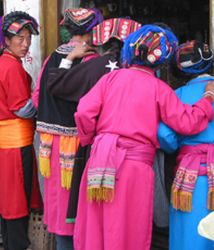Qiang Profile
Autonym: rmi, rme, rmə
Other names: 羌
The Qiang are known to have existed in China from as early as 4000 years ago, probably originating in the northwest of China before migrating down to their present location in Sichuan. They are one of the 55 official minority nationalities in China, and have never been reckoned as Tibetan. The Qiang population is now about 170,000 people, mainly concentrated in parts of Aba Prefecture and Mianyang District, with a few also in Danba County of Ganzi Prefecture.
The Qiang language can be subdivided into several regional strands, varying in pronunciation, vocabulary and use of tones. However, Qiang in Wenchuan County is rapidly losing ground to Chinese (Sichuan dialect), and many of the younger generation do not speak it at all, while in Beichuan, Pingwu and Danba Counties the Qiang language has already completely died out.
Traditionally, the Qiang have a mixture of religious beliefs, often animism, but also elements of Tibetan Buddhism, Daoism and other superstitions that have been adopted from neighboring people groups. They are famous for building stone houses and watchtowers, and building dams and suspension bridges. They place white stones on the corners of roofs as symbols of their gods protecting them and their livestock from harm. Nevertheless, the tragic Wenchuan earthquake of May 12, 2008 killed an estimated 30,000 Qiang. Beichuan County Seat bore the worst of the devastation and will never be rebuilt on that site; it has been preserved and turned into a museum and memorial.


